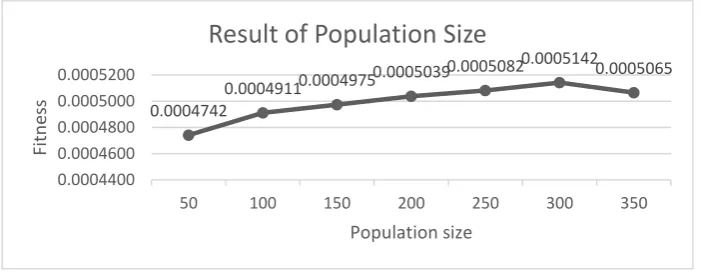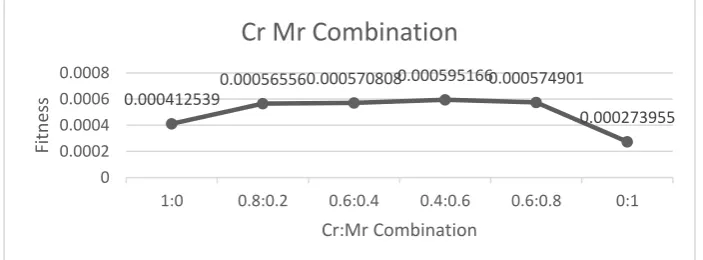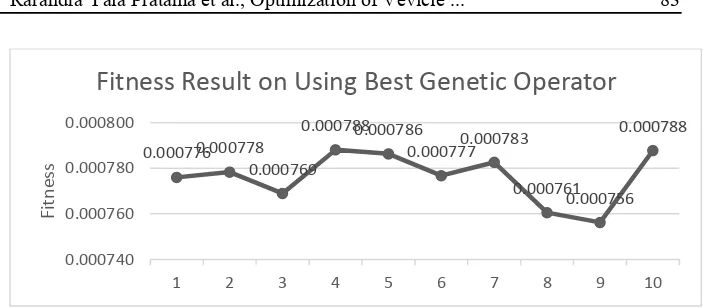Window (Vrptw) For Food Product Distribution Using
Genetics Algorithm
Rayandra Yala Pratama1 and Wayan Firdaus Mahmudy2 2Department of Computer Science, University of Brawijaya, 8 Veteran Road,
Malang, Indonesia, 65145
1[email protected], 2[email protected]
Abstract. Food distribution process is very important task because the product can expire during distribution and the further the distance the greater the cost. Determining the route will be more difficult if all cus-tomers have their own time to be visited. This problem is known as the Vehicle Routing Problem with Time Windows (VRPTW). VRPTW prob-lems can be solved using genetic algorithms because genetic algorithms generate multiple solutions at once. Genetic algorithms generate chromo-somes from serial numbers that represent the customer number to visit. These chromosomes are used in the calculation process together with oth-er genetic opoth-erators such as population size, numboth-er of genoth-erations, crossover and mutation rate. The results show that the best population size is 300, 3,000 generations, the combination of crossover and mutation rate is 0.4:0.6 and the best selection method is elitist selection. Using a data test, the best parameters give a good solution that minimize the distribu-tion route.
1
Introduction
Food product distribution is an activity of food industry for fulfilling customer need due to product ordering. Distribution can become a serious problem if too many customers are listed, so it requires a lot of time to choose the shortest one among all possible routes. The further route taken, the greater cost are needed. The products should distribute fast and efficiently because they have expired date. Determining route will be more difficult if each customers have specific time schedule on receiving distribution product. This problem also called vehicle routing problem with time win-dow (VRPTW).
This study will use genetic algorithm to solve vehicle routing problem with time window on food product distribution.
2
Genetic Algorithm
Genetic algorithm (GA) is part of evolution algorithm that applied in many other field like biology, physic, social and etc. GA could solve many complex problems and developed rapidly [6]. GA has some steps: (1) representing chromosome, (2) initializ-ing population, (3) doinitializ-ing reproduction, (4) calculatinitializ-ing fitness, (5) selectinitializ-ing chromo-some to proceed to the next generation. There are 4 representation of chromochromo-some such as binary, octal, hexadecimal and permutation. Population are generated from chromosomes. Reproduction is creating new chromosome from previous chromosome through crossover and mutation. Each chromosome in the population (after doing reproduction) is being calculated to get fitness. Chromosomes that surpass minimum fitness are being used for next generation. GA’s steps:
Pseudo code for GA [7] is:
Initialize (population) Evaluate (population) While (not stop) do {
Crossover (chromosome) Mutation (chromosome)
Calculate fitness (population) }
The iteration will be repeated until maximum number of iteration passed.
3
Genetic Algorithm with Proposed Approach
This section explain about solving VRPTW problem using genetic algorithm. We use data from VRPTW benchmark problem with R101 for more precisely. There are 100 customers that have different location which describe as coordinate. Each cus-tomer has different ready time, demand but same service time. Ready time is used to calculate time penalty, otherwise demand is used to calculate demand penalty. This study use 25 vehicle which has 200 capacity.
3.1 Chromosome Representation
cutomers. Based on permutation encoding, it will generate chromosome X [1 2 3 4 5 6 7 8 9 10]. Chromosome X show that the sequence of distribution is start from custom-er 1 to customcustom-er 10.
3.2 Reproduction
Reproduction is process to produce child/offspring from parent chromosome. In GA, reproduction consist of crossover and mutation. Crossover is method to exchange gene from one chromosome to gene from another chromosome. Mutation is method to exchange gene in a chromosome.
Ordered Crossover (OX)
Order crossover exchange genes two chromosomes to produce 2 offspring, but this study only take 1 offspring. This crossover begin with choosing two random chromo-somes and select two cut points from each chromosome. The genes between those cut point are copied to the offspring. Then, exchange the rest of genes within both chro-mosome and remove same number. After that, fill the empty genes of offspring with genes from the previous process start from the second cut point then continue from beginning of chromosome after the last gene filled.
Reciprocal Mutation
Reciprocal mutation is integer representation-type of mutation. Reciprocal muta-tion exchange two genes from a chromosome after being randomly selected. 1 off-spring are produced by reciprocal mutation. This reciprocal mutation is suitable for VRPTW problem because after being exchanged, there are no same gene and main-tain the sequence.
3.3 Fitness
Fitness on each chromosome is calculated every iteration. Before selection begin, each chromosome on the population is being calculated to get its fitness. Before cal-culating fitness on each chromosome, we need to calculate capacity and time penalty. Since each chromosome has coordinate, we use Euclidean distance to calculate dis-tance between two chromosomes. The Euclidean disdis-tance equation is shown in equa-tion (1).
√(XA-XB)2+(YA-YB)2 (1)
Where X is X coordinate from chromosome A and B, Y is Y coordinate from chromosome A and B.
The vehicle speed is constant 2 unit, so to get vehicle travel time we multiply the distance with vehicle speed. Time penalty is given to vehicle which has arrive before
customer’s ready time. Capacity penalty is given to vehicle which has less product
fitness= ∑ D+ ∑ P1 (2)
Where
∑ 𝐷
is total distance from all customer, and∑
𝑃is total penalty given
to vehicle.
3.4 Selection
After calculating fitness on each chromosome, next step in GA is doing selection. Chromosomes are being selected based on fitness value. If the chromosome pass the minimum fitness (fit for next generation), then it will be used for next generation. This study use two kinds of selection, that are elitism and binary selection.
Elitism Selection
This selection method maintain best chromosome to be used in next generation. This happened because elitism sort all chromosomes from the highest fitness. Top n-chromosomes are selected for next generation. Steps for elitism selection are:
1. Sort chromosomes in the population start from highest fitness. 2. Select top n-chromosomes. (n = initial population)
Binary Tournament Selection
Binary tournament selection works like tournament system which compare fitness from two selected chromosomes. Chromosomes are selected randomly, so chromo-some with low fitness is possible to continue to next generation. Steps for binary tournament selection are:
1. For n (n = initial population), do:
a. Select two chromosome randomly
b. Select one chromosome which has better fitness
4
Result and Discussion
This study is implemented using Java programming language and personal com-puter that has specification such as Intel Core i5 Processor with 2.5 GHz clock speed, 4 GB DDR3 RAM and Nvidia Geforce 525M graphic card. GA is a stochastic method that has different result for different run, so we run 10 times for each categories with same initial parameter.
Figure 1. Result of comparison between Elitism and Binary Tournament selec-tion
It show that Elitism selection has better average fitness compare to Binary Tour-nament selection. Elitism has 0.000593 while binary tourTour-nament has 0.000279. Elit-ism selection has better fitness than binary tournament because elitElit-ism maintain chromosomes that have best fitness from previous generation to continue to next gen-eration. Different from elitism selection, binary tournament select two chromosomes randomly so there is a chance that chromosomes with low fitness are selected.
Second is comparing population size. For genetic operator, we use 100 generation, 0.5 crossover and mutation rate. Elitism selection is used. Range of population size that used is 50 to 350 with multiple of 50. The result show that 300 is optimal popula-tion size for this problem with 0.0005142 fitness. The result is shown in Figure 2.
Figure 2. Result of Population size comparison
Comparing generation is the third. We use 100 population size, 0.5 crossover and mutation rate with elitism selection. Generation that used is 500 to 3500 with multiple of 500. The result show that 3000 is optimal generation with fitness of 0.000755. The result is shown in Figure 3.
1 2 3 4 5 6 7 8 9 10
Elitism 6E-04 6E-04 6E-04 6E-04 6E-04 6E-04 6E-04 6E-04 6E-04 6E-04 Binary T. 3E-04 3E-04 3E-04 3E-04 3E-04 2E-04 2E-04 3E-04 3E-04 3E-04
0
Figure 3. Result of Generation comparison
Fourth is comparing crossover and mutation rate combination. We use 50 popula-tion size, 500 generapopula-tion. Crossover and mutapopula-tion rate combinapopula-tion is 0 to 1 with 0.2 difference. Selection that used is elitism selection. The result show that the best fit-ness come from crossover and mutation rate combination of 0.4:0.6 with 0.000595 fitness average. The result is shown in Figure 4.
Figure 4. Result of comparison in crossover and mutation rate combination
Last category is to find out fitness from best genetic operator. From previous cate-gory, it is found that best population size is 300, best generation is 3000 and crossover and mutation rate combination is 0.4:0.6. This category, we use best genetic operator to get best fitness. We also use Elitism selection. The result show that best fitness is 0.000788. The result is shown in Figure 5.
0.000624 0.000685 0.000703 0.000732 0.000741
0.000755 0.0007542
0.000000 0.000200 0.000400 0.000600 0.000800
500 1000 1500 2000 2500 3000 3500
Fi
tn
e
ss
Generation
Generation Comparison
0.000412539
0.000565560.0005708080.0005951660.000574901
0.000273955
0 0.0002 0.0004 0.0006 0.0008
1:0 0.8:0.2 0.6:0.4 0.4:0.6 0.6:0.8 0:1
Fi
tn
e
ss
Figure 5. Fitness result from best genetic operator
Figure 5 shows that the best fitness is calculated from 4th and 10th trial. Although the chromosomes result are different but they produce same fitness (0.000788), so the 4th trial is chosen. The chromosome from the 4th trial is shown in table 1.
Table 1. Chromosome from the 4th trial result
Chromosome from the 4th trial
[23, 81, 29, 35, 48, 43, 75, 49, 69, 27, 53, 26, 19, 42, 73, 67, 10, 8, 14, 16, 70, 28, 55, 71, 58, 52, 13, 47, 90, 89, 6, 56, 32, 4, 51, 68, 22, 12, 77, 79, 2, 18, 98, 17, 7, 37, 87, 72, 15, 83, 59, 99, 41, 39, 66, 3, 57, 21, 76, 24, 40, 54, 9, 33, 20, 1, 82, 91, 88, 96, 92, 46, 11, 93, 100, 36, 62, 5, 84, 44, 31, 60, 85, 45, 74, 50, 80, 78, 30, 25, 65, 34, 63, 94, 97, 95, 64, 61, 86, 38]
From the table 1, the chromosome is a representation of customer’s sequence that have to be visited. The distribution start from 23rd customer and then stop at 38th. Total distance is 1264.85 unit and the distribution process takes 258.37 time unit.
5
Conclusion
This study conclude that VRPTW problem can be solved using genetic algorithms. GA generate chromosome from 100 customers randomly, evaluating each chromo-some than select chromochromo-somes that fit for next generation based on their fitness. This study also point out that elitism selection is better than binary tournament because it maintain chromosomes with best fitness to be the next generation. Fitness is influ-enced by genetic operator. 300 population size, 300 generation and 0.4:0.6 combina-tion of crossover and mutacombina-tion rate is best genetic operator that produce best fitness. Best genetic operator produce fitness of 0.000788.
0.0007760.000778 0.000769
0.0007880.000786
0.0007770.000783
0.000761 0.000756
0.000788
0.000740 0.000760 0.000780 0.000800
1 2 3 4 5 6 7 8 9 10
Fi
tn
e
ss
References
[1]Mahmudy, Wayan Firdaus, Improved Simulated Annealing For Optimization Of Vehicle Routing Problem With Time Windows (VRPTW), 2014. Kursor Journal, vol. 7, no. 3, page 109-116.
[2]Puljic, K., Manger, R., A Distributed Evolutionary Algorithm With A Superlinear Speedup For Solving The Vehicle Routing Problem, 2012. Computing and informatics.
[3]Li, P. dkk, Vehicle Routing Problem with Soft Time Windows Based on Improved Genetic Algorithm for Fruits and Vegetables Distribution, 2015. Hindawi Publishing Corporation.
[4]Nazif, H., Lee, L.S, Optimized Crossover Genetic Algorithm for Vehicle Routing Problem with Time Windows, 2010. American Journal of Applied Sciences.
[5]Saputri, M.W, Mahmudy, W.F & Ratnawati, D.E, “Optimasi Vehicle Routing Problem with Time Window (VRPTW) Menggunakan Algoritma Genetika
Pada Distribusi Barang”, 2015. Jurnal Skripsi Mahasiswa PTIIK Universitas
Brawijaya.
[6]Mahmudy, W.F, “Modul Algoritma Evolusi”, 2013. Modul Kuliah Semester
Ganjil 2013-2014 PTIIK Universitas Brawijaya.
[7]Srivastava, P.R, Kim, T., Application of Genetic Algorithm in Software Testing, 2009. International Journal of Software Engineering and Its Applicantions, Vol. 3 No. 4.
[8]Sundarningsih, D., Mahmudy, W.F, & Sutrisno, “Penerapan Algoritma Genetika Untuk Optimasi Veehicle Routing Problem With Time Window
(VRPTW) : Studi Kasus Air Minum Kemasan”, 2015. Jurnal Skripsi
Mahasiswa PTIIK Universitas Brawijaya.
[9]Gandhi, S., Khan, D., & Solanki, V.S, A Comparative Analysis of Selection Scheme, 2012. International Journal od Soft Computing and Engineering (IJSCE).
[10]Hlaing, Z.C.S.S, Khine, M.A., Solving Traveling Salesman Problem by Using Improved And Colony Optimization Algorithm, 2011. International Journal of Information and Education Technology.
[11]Kumar, A., Encoding Schemes in Genetic Algorithm, 2013. International Journal of Advanced Research in IT and Engineering.


